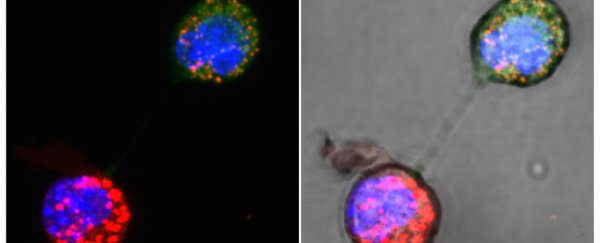For the first time, scientists have demonstrated how DNA can move between cells in a tumour, which opens up the possibility of replacing defective genes with healthy, custom-made genes that can fight the cancer from the inside out.
The team, from the Malaghan Institute of Medical Research in New Zealand, discovered that when mitochondrial DNA was removed from mouse models of breast cancer and melanoma, after about a month or so, this DNA was naturally replaced by the surrounding healthy tissue.
This allowed the cancer to form tumours and continue spreading around the body, because mitochondrial DNA is responsible for encoding key proteins that are used in the process of converting the energy from our food into the chemical energy that we use to fuel our brain and muscle function. This is different from nuclear DNA, which is responsible for encoding characteristics such as hair colour, height and sex.
"Initially we thought the cells had learned to grow without needing mitochondrial DNA," said lead researcher and cell biologist Mike Berridge, in a press release. "But when we presented the research at a conference, a well-known scientist asked if we had tested the growing cells to see if they contained mitochondrial DNA. We hadn't."
Prior to this research, it was thought that mitochondrial DNA stayed put within our cells in all situations other than in reproduction. This theory was so solid, you'll find it in your high school biology textbooks.
"Our findings overturn the dogma that genes of higher organisms are usually constrained within cells except during reproduction," said Berridge. "It may be that mitochondrial gene transfer between different cells is actually quite a common biological occurrence."
Publishing their findings in the journal Cell Metabolism, the team suggests that, now knowing this, we can figure out how to turn this process against developing cancers. Defective mitochondrial DNA is known to cause around 200 diseases, characterised by the way they affect a person's hearing, eyesight, brain and muscle function, and is being investigated for a whole lot more. The researchers suggest that perhaps synthetic mitochondrial DNA could be custom-designed to replace the defective genes and stop tumours and other diseases from developing.
"This appears to be a basic physiological mechanism in the body that no one has seen before because they lacked the exploratory tools," said Berridge. "Whether this new phenomenon is important in tumour formation is still unclear, but we are interested in pursuing the research to see if the transfer occurs more widely in the body. Preliminary evidence indicates it may be a common occurrence in the brain."
Sources: io9, Malaghan Institute of Medical Research
